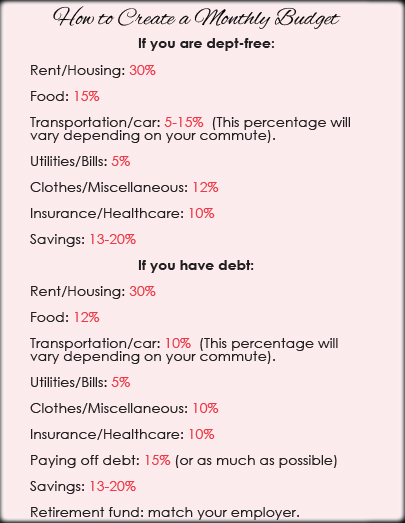I have never been a big spender, but until recently, I was a fairly absent-minded spender. Accustomed to having just enough month-to-month, I never gave much thought to saving money. I assumed that getting in touch with my spending habits would be yucky and laced with guilt. A few months ago, I realized I was sick of being sloppy with money, and I’m too smart not to adopt a very basic, controlled spending style. Here are a few things that made my relationship with my money a pleasant one.
1. If you do nothing else, live on cash as much as possible. Suddenly, spending money feels different. Although I always pay off my credit card bills (don’t let this fool you—I’m not a total angel with my money), I spend smarter when I’m handing over dear, tangible cash.
Of course, not all purchases can be made with cash. Perhaps the marketing book that will help you build your business is most affordable on Amazon or your utilities bill is automatically deducted from your credit card. Use your credit card for these purchases only if you know you will pay the minimum off on time—this will maintain and build your credit score. Research to find out what kind of credit card offers the rewards (points, cash, miles, “concierge”-like customer service) that suit you. Last year, I traded in my points for $75, which I used towards rent. If you have trouble paying off your credit card on time, go debit. You won’t build up your credit score, but you also won’t destroy it while accumulating ever-increasing debt.
2. Establish clear goals and be specific as possible. Turn “I’d like to save more money” into “I’d like to add $200 to my savings account every month for my upcoming move.” Well-defined goals are the foundation of a doable action plan (which you need, too!) To reach my $200/mo. goal, I know I should deposit $100 in my savings account on my (biweekly) payday—before I have a chance to spend it.
3. Precision matters. Live It Love It Earn It author Marianna Olszewski advises us to never be vague about money. “Without knowledge, fuzzy emotions and inaccurate information control our money behavior when information and common sense should be guiding our decisions.”
4. On that note…Commit to keeping a spending diary. With each entry, include exactly how much you spent (including tips, if applicable) and which category your purchase falls under—transportation, healthcare, etc. Schedule a time to review your spending diary at least once a week. Every Friday I look through the week’s purchases to remind myself how much I have left in my budgeted categories. I can also see when I’ve spent a good amount in, oh, beauty products, so I know to take it easy on that front for the rest of the month so I don’t go over my beauty budget.
If you like to use a credit card for more of your purchases, try using a budgeting app/website to keep yourself on track. Mint.com offers free and convenient way to organize all your purchases by category, check out how much of your monthly budget you’ve spent, and see your financial progress.
5. Create an appropriate budget. I sort of had a budget in college. It mainly revolved around how much money I’d allow myself to spend on makeup at the drugstore—one of the few stores within walking distance in our rural area! But whatever amount I put down as my limit was pretty arbitrary. Arbitrary budgets are doomed to failure because they’re not rooted in real figures (remember, be precise!).
For the past two months, I’ve been working on sticking to a budget I adapted from the budget guidelines in Catey Hill’s book on financial savvy, SHOO, Jimmy Choo!
Since buying organic food is important to me, I allow a little more room in my food budget (and limit eating out to a few times a month). My commute to work is fairly short, and my sweet Camry gets pretty good mileage, so I have a small gas budget. While I have cut down on miscellaneous expenses (beauty, clothes, etc.), it is hard to stick to only 12%; but I’m making progress by being 100% aware of spending in this category.
6. Spend consciously. Exercise that prefrontal cortex! (The part of the brain reins in our impulses). It happens almost everyday: a desire for something I don’t have pops into my head—nude ballet flats, a rich eye cream, the perfect shade of ruby nail polish… In order to reduce over-spending on these nice—but usually unnecessary—items, I make a list and figure out which one or two things are most important to me.
I then research how to get the best price on these items. For example, can you buy a refurbished or lightly used version of X electronic devise? Can you score a 25% discount by googling “X clothing store promo code/coupon?”
Put time between the desire and the purchase. Sleep on it, or put your list away for a few days.
Finally, don’t mix emotions and spending. When we’re emotional, we tend to forget or undervalue our long-term saving/debt-reduction goals. In my own experience, “retail therapy” usually ends in feeling crummier.
7. Create two savings accounts. Build an emergency savings account. Imagine losing your job—how much would you need to live comfortably for at least six months while you get back on your feet? Work towards accumulating this amount (and more).
Start a high-interest retirement account. I know what you’re thinking—but I’m only twenty-something! I have plenty of time to start saving for retirement! Don’t wait—think about the interest you can accumulate in a decade. Because I have a fairly modest salary and my employer doesn’t offer retirement benefits, I opened a roth IRA. If you don’t already have a retirement plan, consult with your bank to see which type of plan is most appropriate for you and your current employment situation. (Also, both books I mentioned above offer great advice on this matter!) Don’t forget to shop around for the best interest rate.
Although these steps are fairly basic, they can be challenging. Have patience with yourself. I know I still have a long ways to go before I can even begin to think about buying a house or investing—one step at a time!
Related: 6 Best Tips for Being Vegan on a Budget
How Much It Costs to be Vegan in ____
__
Photos: corkor via Etsy; liuliuliu via Flickr







